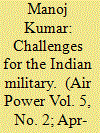| Srl | Item |
| 1 |
ID:
096018


|
|
|
| 2 |
ID:
162916


|
|
|
|
|
| Summary/Abstract |
Regional air pollution is strongly impacted by transportation emissions. Policy mechanisms to reduce emissions are required to reach environmental quality goals. Projecting the drivers (e.g., technical, economic, societal, regulatory) that will impact future emissions is challenging, and assessing regional air quality (AQ) is complicated by the need for detailed modeling tools and data inputs to simulate chemistry and transport of pollutants. This work assesses the contribution of emissions from transportation sources to ground-level concentrations of ozone and fine particulate matter via two methods. First, impacts are quantified for three U.S. regions including California using output from an economic optimization model to grow a base year emissions inventory to 2055. Second, impacts are considered for California using state-level projections with an updated emissions inventory and modeling suite in 2035. For both, advanced AQ models are used, showing that the impacts of light duty vehicles are moderate, reflecting shifts to more efficient and lower emitting technologies. In contrast, heavy duty vehicles, ships, and off-road equipment are associated with important ozone and PM2.5 burdens. Emissions from petroleum fuel production and distribution activities also have notable impacts on ozone and PM2.5. These transportation sub-sectors should be the focus of future emissions reduction policies.
|
|
|
|
|
|
|
|
|
|
|
|
|
|
|
|
| 3 |
ID:
187836


|
|
|
|
|
| Summary/Abstract |
China has exerted great efforts in the past decades to fight against particulate matters and has achieved initial results, but ozone pollution has increased significantly. Using a unique diagnostic data of a peninsula city in China, this study evaluates the health effect of ozone pollution on emergency room admission and medical expenditure. We present strong evidence that ozone has a significant negative impact on health. Specifically, one standard deviation increase in ozone pollution will result in an additional 3.30, 2.25, and 4.94 weekly emergency room admissions in respiratory, ophthalmology, and internal medicine. Our analysis of medical expenditure implies that one standard deviation increase of ozone pollution generates a 5.89 million yuan increase of annual medical expenditure for a representative city. We further show that land wind, sunny weather, and dense roads significantly moderate the adverse health effects of ozone. Our findings offer a timely reminder for policymakers to pay attention to “invisible” ozone pollution while managing particulate pollution.
|
|
|
|
|
|
|
|
|
|
|
|
|
|
|
|